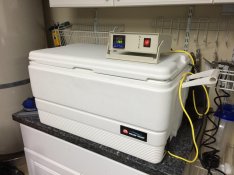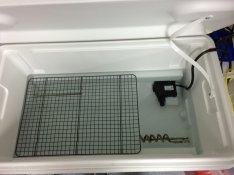Proportional controllers are nice, but fairly expensive.
I guess it depends on your definition of expensive! You should be able to buy a nice one for US $30 or less, even on that unmentionable auction site.
Proportional controllers are nice, but fairly expensive.
So I have developed my first roll of C-41 using my water bath and aquarium heater/water pump setup. For the most part I'm pretty satisfied with the results,but there are a couple questions about the way the film turned out. Specifically, some of the pictures have really bad grain, and the picture of the table saw seems to have a lot of something. Below is the link to the pictures and I would really appreciate some feedback and comments.
https://plus.google.com/u/0/photos
The pictures were taken with a "new"(to me) Maxxum 300xi, set to automatic with kodak max 400, in my mother-in-law's house and basement of random things.


I use a microprocessor controlled water bath I bought off ebay for $20. the tank it roughly 20" x 20" and 6" deep. I can set it for 105 degrees for E6 and it holds that temp within a quarter of a degree. .
 I don't think MacGyver has that kind of money.
I don't think MacGyver has that kind of money. 
I use this controller
http://www.newark.com/omron-industr...ontroller-temp-1-16-din-100-240vac/dp/58T9504
with this solid state relay so I can have it switches on and off very rapidly
http://www.newark.com/crydom/d2425/...rydom Top Seller&MER=PSPSO_S_C_Crydom_93K7541
I use them only because I have them on hand. A great number of others will work fine. Pricing about the same for simple one. Or you can buy the one that the OP used.
and only $200 for the controller alone?I don't think MacGyver has that kind of money.
I wonder if a circulating pump would prevent the problem Lamar reports re: temperature drift?
I was all ready to develop my first C-41, or so I thought, till I realized my aquarium heater wont get me there. I've been trying to MacGyver my titanium ViaAqua aquarium heater but haven't had success. Even after maxing out the trim screw it can't maintain 103, and the adjusting post that the knob attaches to has an internal stop that I'm afraid to mess with. Being only 75 watt I'm not sure its powerful enough anyway. I need an alternative, cheap and fast. My chems are already mixed.
Make? Model?
Wayne, go on Amazon and search for an immersion water heater. They are used to heat small pots or cups of water for tea, typically. They have a handle and a curled wire that is immersed. You can get them for less than $20, and they are rated at as much as 1200 watts or even more. Pay attention to the voltage though - some on Amazon are 250v/6 amp devices, you don't want them. And those are more expensive. These latter devices are typically replacement heaters for hot water heater tanks. You can tell these by the lack of a handle, and instead a threaded base. Those are typically 250v devices, but if you find a 110 v device and can fabricate the threaded receiver socket, it would be a more "professional" solution than the little immersion heater.
Those might work but would require a separate temperature control which I am incapable of MacGyvering without specific (and very simple) instructions.
Don't let my tampering with the ViaAqua lead you to believe I have even a smidgeon of electrical knowledge. I know not to bring a toaster into the bathtub, and that's about it.

 I see more of these in my future.
I see more of these in my future. Oh..nevermind. There are dozens of these on ebay in various makes and models. They look very nice; the trick will be getting a good one cheap.
Your SSR might be limiting current to the heater coil. Check the amperage rating of the SSR compared against the required amps for the heater. Or compare power: output voltage of SSR times amps. Compare to power required for heater.
If thats the case, you would just need a relay rated at 12 or 20 amps or so.
What is the wattage of the heating element and what is the volume of water in the bath?
| Photrio.com contains affiliate links to products. We may receive a commission for purchases made through these links. To read our full affiliate disclosure statement please click Here. |
PHOTRIO PARTNERS EQUALLY FUNDING OUR COMMUNITY:  |